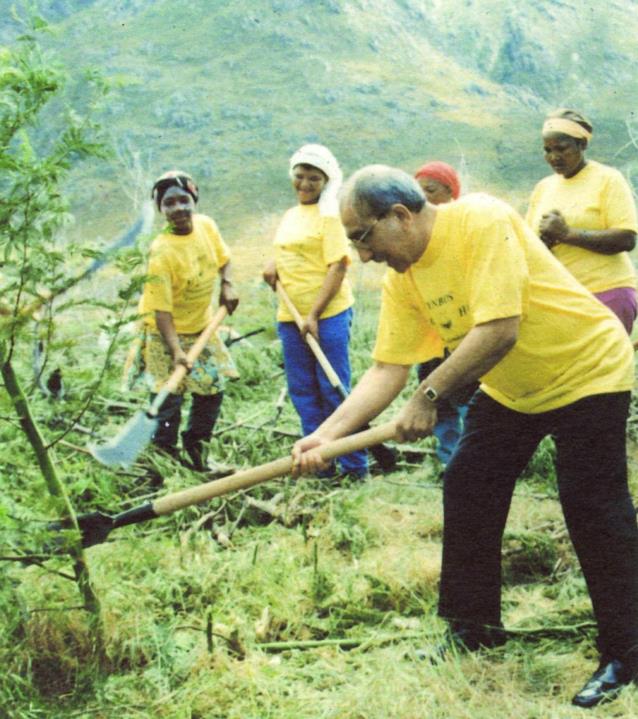
cutting down the first black wattle (Acacia mearnsii) on 16 October 1995,
heralding the official start of South Africa’s biggest Public Employment
Programme, the Working for Water programme.
It is estimated that about 7% of South Africa’s mean annual run-off is lost to very thirsty alien invasive plant species. This is about 3.3 billion cubic metres more than equivalent indigenous plant species would consume. This equates to over four times the mean annual run-off of the entire uMngeni River Basin. In a country that is already water insecure this is not a volume we can afford to lose – these invasive plants fundamentally threaten environmental, water and economic security. This is recognised and appreciated by both government and civil society.
Established in 1995, the national Department of Environmental Affairs has a long-running programme dedicated to the removal of alien invasive plants and the restoration of degraded natural ecosystems. It is called the Natural Resource Management (NRM) Programme and comprises, amongst other, the Working for Water, Working for Wetlands and Working on Fire campaigns. The current annual total spend is about R 2 billion, much of it used to create labour-based job opportunities.
Recently the leadership of this programme realised that, in order to improve the sustainability of the programme and its impact, increased buy-in from other government departments, NGOs, local communities and from the large labour force was required – instead of being a programme it needed to become an integrated multi-stakeholder sector. This demanded a move from a technically focused approach to one that embraced in greater detail the social, economic and governance aspects of natural resource management.
With this in mind the NRM Programme convened a two-day ‘science meets practice’ workshop in Grahamstown. The entire senior management of the programme participated and it was led by Professor Tally Palmer and Dr Harry Biggs, two internationally respected South African academics. As part of the proceedings action-researchers from Conservation South Africa, Rhodes University, AWARD and the International Water Security Network (through the Institute of Natural Resources) presented their experiences of supporting the implementation of social-ecological systems (SES) and resilience-based approaches to catchment management in various areas of South Africa.
The response from the NRM managers was unanimously positive and enthusiastic. They identified with, and took ownership of, terms they had not previously encountered – polycentric governance, diversity and redundancy, slow variables and feedbacks. Why was the response so positive? Quite simply, these concepts informed the many challenges that these managers encounter everyday – how do we secure the buy-in and participation of others; how do we get local land-users to take ownership; how do we deal with uncertainty; how do we learn and communicate as we proceed; how do we connect the dots of cause and effect? The immediate impact of this engagement was more than any of us could have imagined.
These are early steps to establish a foundation for growth and consolidation of the NRM sector, but the first steps have been taken. The next steps are equally challenging – embedding this thinking in the rank-and-file of the organisation and partnering organisations in the sector.
Apart from its obvious success there were two invaluable lessons learnt from this process. The first was that when managers invite scientists into the room and request of them their knowledge, information and wisdom it is far more productive than scientists trying to stuff their work down managers’ throats. Second, like almost all facets of our professional and personal lives, timing is everything – this is an idea whose time has come!
